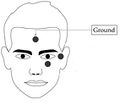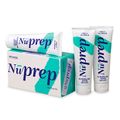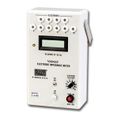Subject Preparation: EOG: Difference between revisions
(Adding Post-Study Disinfection Instructions) |
|||
| Line 140: | Line 140: | ||
''Note: if recording only EOG (no EEG) you will still need to have a ground electrode.'' |
''Note: if recording only EOG (no EEG) you will still need to have a ground electrode.'' |
||
== Post-Study Disinfection == |
|||
If you are using disposable electrodes, discard the electrode and clean the electrode lead with alcohol. |
|||
If you are using reusable electrodes, they must be sent to Sterile Processing Services for sterilization. |
|||
Revision as of 12:23, 14 January 2022
Electroculogram (EOG) Eye Lead Placement
Used to identify and monitor eye blinks (VEOG - vertical eye movement) and saccades (HEOG - horizontal eye movement). This is a one channel montage which is designed to pick up horizontal and vertical eye movement from both eyes. There are many ways to monitor eye movements- some montages use one channel and some use two channels. Selection is usually based upon the reason(s) for monitoring the eye movement.
- Left Infra Orbital (LIO) - Place electrode on the orbital ridge centered directly under the eye.
- Left Outer Canthus (LOC) - Place electrode at the lateral junction of the upper and lower eye lid.
- Clean the skin on the cheek near the eyes and behind the left ear with alcohol and Nuprep Skin Cleaner. Wipe the skin to remove the gritty residue.
- Attach the Large EEG Adhesive Washers to the electrodes.
- Place the Infra Orbital electrode.
- Place the Outer Canthus electrode.
- Place a ground electrode on forehead or the left mastoid bone behind the ear.
- Press the electrodes onto skin.
- Apply Elifix Electrolyte through the electrode opening.
- Check the impedances using the Grass Impedance Meter.
- Plug in the left infra orbital electrode in jack# 1 and the left outer Canthus electrode in jack# 2 and the ground into jack# 3.
- Push the red ON button.
- The Electrode Selector should be at 1 or 2.
- EOG impedance should be < 50k ohms.
- Secure with tape.
- Refer to section entitled “Electrode Impedance Meter Check” for more detailed information on reducing impedance.
- If you require further assistance, please request technical assistance from MEG staff.
-
Left Eye One Channel EOG
-
Reducing Skin Impedances
Nuprep or Lemon Prep can be used for reducing skin impedance. Both are topical abrasives used to clean the skin to remove any natural or applied oil, lotions and/or dead skin. Remove with water.
- Insert the wooden end of a cotton swab through the opening of the electrode to push hair aside (in one direction) until the skin is clearly visible.
- If the hair is long, lift up the electrode a little and let it down again while moving back the swab to grab a new bunch of hair (this will prevent the hair from slipping back).
- Dip the swab into the Nuprep (Abralyt or other skin prep) and insert through the electrode opening.
- Twirl the swab against the skin using the thumb and index finger.
- | class="wikitable"
|-
|
-
Nuprep -
Lemon Prep
|}
Applying Electrolyte
Elifix and Ten/20 Conductive Creams are opaque white, water soluble electrolytes substances used as a conductive and/or fixing/adhering mediums to attach electrodes. Removed with warm water.
- *If using Elifix or Abralyt - fill a syringe with the cream.
- - Squirt into the middle of each electrode opening.
- *If using Ten/20 - scoop paste into a cup electrode (this paste is too thick to squirt from a syringe).
- - Press firmly on the skin.
- *Completely fill the electrode space (the space from the skin to the electrode) with cream / paste so that there are no air pockets and the electrolyte makes good contact with the skin.
- *If using Elifix or Abralyt - fill a syringe with the cream.
-
Ten/20 Conductive Paste
-
If the electrodes are closely spaced, when using Elifix or Abralyt, in order to prevent "electrode bridging" draw back the syringe concurrently to prevent electrolyte from swelling underneath the electrode rim and bridging to the adjacent electrodes. When using Ten/20 do not allow the paste from adjacent electrodes to touch
Electrode Impedance Meter Check
The Grass S88 Impedance Meter measures AC impedance (resistance and capacitance). An impedance check should be performed on all electrodes used for EEG or EMG. When two or more electrodes are plugged into the electrode switch positions, all electrodes except the one selected electrode being measured are connected together and provide the reference for the one being measured.
-
Grass Impedance Meter
-
- 1. The Electrode Selector Switch should be at Jack position 1 or 2.
- 2. Plug the ground electrode (FPz) into electrode Jack 1 position.
- 3. Plug the other electrodes into the Jack (2, 3, 4, etc) positions in a systematic manner one at a time.
- 4. Press the Red ON Button to activate the impedance check. The power will automatically shutoff after approximately 2 minutes. (There is no OFF button.)
- 5. If the impedance is too high - take a cotton tip swab dipped in Nuprep (Abralyt or other skin prep) and twirl against the skin until impedance is at an appropriate level. Then re-insert Elifix electrolyte.
- Impedance Recommendations
EEG Electrodes ≤ 5Kohms EMG/EOG/ECG ≤ 50Kohms
- 6. After checking the impedance of each electrode plug the electrode into the appropriate Electrode Jackbox / Amplifier Position.
*If the electrode impedance exceeds 199.9K ohm, a “1” will appear in the left display window with all other digits blanked out indicating the impedance is too high. Take a cotton swab that has been dipped in Nuprep and insert it through the electrode opening and twirl against the skin. Re-apply electrolyte. Re-check the impedance.
MEG DSQ 3500 Amplifier Setup
Located inside the MSR on the table near the MEG machine. The DSQ 3500 Amplifier has inputs for:
- Fiducial Coils - Nasion, Left Ear, Right Ear, Inion(unused) and Vertex(unused);
- 21 Unipolar Jacks - there are 21 unipolar channels which measure the difference between an electrode and a common reference channel. The reference channel is common to all of the EEG unipolar channels;
- 8 Bipolar Channels - that measure the potential difference between two individual electrodes. These channels are labelled A - G on the jackbox, however, the channels are numbers 56 to 62 in the parameters;
- ZIF Connector/Jig Connector - for the EEG EasyCap System which can accommodate up to 56 electrode positions;
- Ground Jack - Z;
- Reference Jack - Ref.
Please note: There is a Static Dissipation Button which you must touch before touching anything else on the amplifier and before plugging any electrodes into the amplifier.
- If Using a One Channel Bipolar EOG:
- Plug the electrodes into a bipolar channel.
EOG ELECTRODE Location Bipolar Channel 56 (Channel 56 is the first Bipolar Channel on the Amplifier)
Lt OC Left Outer Canthus Channel-056 A+ (black) Lt IO Left Infra Orbital Channel-056 A- (blue)
Note: if recording only EOG (no EEG) you will still need to have a ground electrode.
Post-Study Disinfection
If you are using disposable electrodes, discard the electrode and clean the electrode lead with alcohol.
If you are using reusable electrodes, they must be sent to Sterile Processing Services for sterilization.




